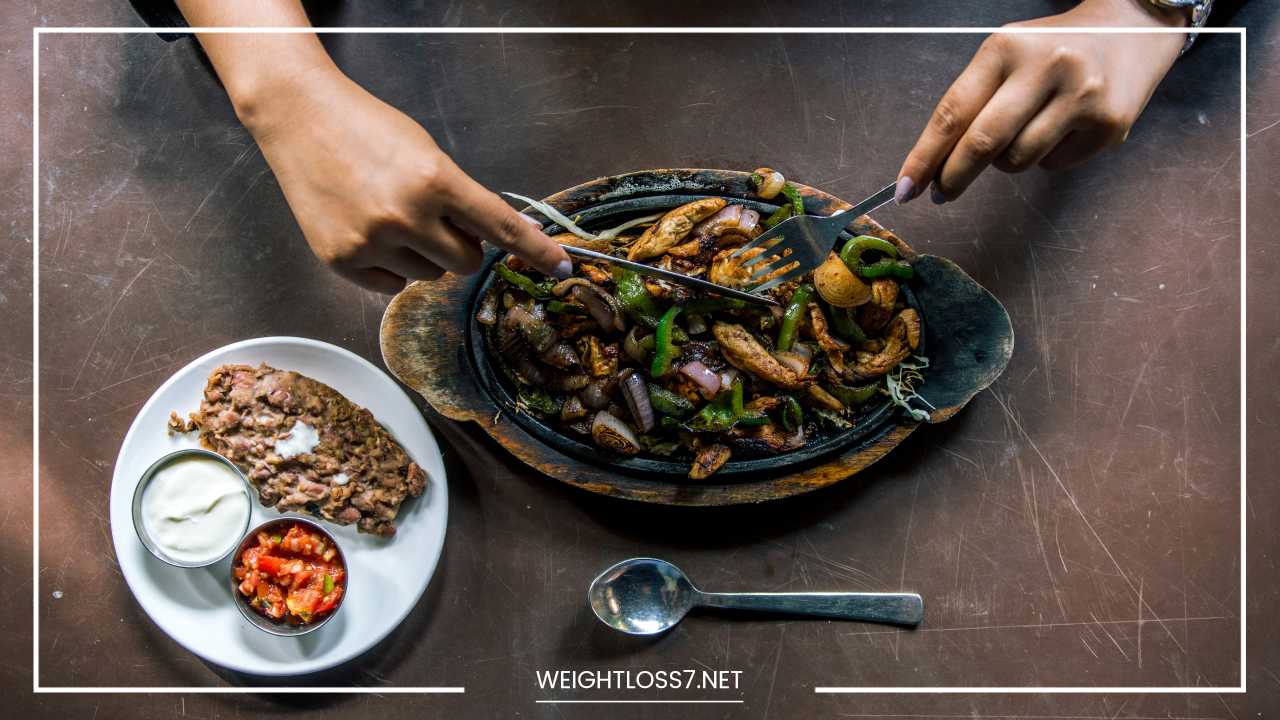How to Lose Weight Even if You Love Food

Love Food
How to Lose Weight Even if You Love Food: A Guide for Foodies
For many of us, food is more than just fuel – it’s a symphony of flavors, a source of comfort, and a way to connect with loved ones and cultures.
But what happens when your inner gourmand clashes with your desire for a healthier weight? Can you truly have both delicious food and a healthy physique? Absolutely!
This comprehensive guide is designed specifically for foodies, chronic snackers, and everyone who appreciates a well-crafted meal. Shedding pounds doesn’t have to mean sacrificing flavor or resorting to bland, repetitive dishes.
Here, we’ll explore sustainable strategies for weight loss that let you keep the joy in food while reaching your health goals.
Mindful Eating: Cultivating Awareness for Healthy Choices
The first step to a successful weight loss journey that integrates your love for food is acknowledging your relationship with it.
Are you an emotional eater who turns to food for comfort when stressed? Do you mindlessly munch while watching TV without even registering the flavors? Identifying your triggers is crucial.
This is where mindful eating comes in. This practice encourages you to slow down, savor each bite, and truly listen to your body’s hunger cues. Here are some tips to cultivate mindful eating habits:
- Create a distraction-free dining environment. Put away your phone, turn off the TV, and dim the lights if desired. The goal is to focus on the meal in front of you, not external stimuli.
- Engage all your senses. Pay attention to the visual appeal of your food – the vibrant colors, the careful arrangement. Appreciate the aromas and textures with each bite.
- Ask yourself if you’re truly hungry. Before reaching for a snack, pause and reflect on your hunger levels. Are you thirsty, bored, or stressed instead? A glass of water, a short walk, or some deep breaths might be all you need.
- Stop when you’re comfortably full. Don’t feel pressured to clean your plate. Our bodies are very good at communicating satiety – listen to those signals and avoid overeating.
Mindful eating takes practice, but it’s a powerful tool for developing healthy habits that support your weight loss journey in the long run.
Smart Swaps: Flavorful Strategies for Portion Control
You don’t have to banish your favorite foods to a lonely corner of the pantry. Instead, focus on making smart swaps that are just as delicious but lower in calories and packed with nutrients.
Here are some strategies to keep your taste buds happy while managing portions:
- Portion control is your best friend. Even healthy foods can lead to weight gain if consumed in excess. Use smaller plates, bowls, and glasses to visually limit your intake. Measure out portions using measuring cups or spoons, especially for calorie-dense foods like nuts and seeds.
- Embrace whole, unprocessed foods. Fruits, vegetables, whole grains, and lean proteins are the cornerstones of a healthy, weight-loss friendly diet. They’re naturally filling and provide essential vitamins, minerals, and fiber that your body needs to function optimally.
- Don’t fear healthy fats. Include healthy fats like avocado, nuts, olive oil, and fatty fish in your diet. They promote satiety, keeping you feeling fuller for longer, and add richness to your meals.
- Limit added sugars and refined carbohydrates. Sugary drinks, processed snacks, and white bread can spike your blood sugar levels, leading to cravings and overeating. Opt for whole-wheat versions of breads and pastas, and choose natural sweeteners like honey or maple syrup in moderation.
- Spice things up with flavor bombs! Spices add depth of flavor without adding calories. Experiment with herbs, spices, and low-sodium seasonings to create delicious, healthy meals. Explore cuisines known for their bold flavors – think Indian curries, Thai stir-fries, or Moroccan tagines.
Embrace Cooking: Your Kitchen as a Weight-Loss Weapon
By taking control of what goes into your meals, you empower yourself to make healthy choices. Here’s how to transform your kitchen into a weight-loss haven:
- Plan your meals in advance. Planning your meals for the week helps you avoid unhealthy choices when hunger strikes and prevents impulse grocery shopping.
- Prep healthy snacks like a boss. Having pre-portioned snacks like carrot sticks, sliced bell peppers with hummus, or yogurt parfaits with granola and berries readily available keeps you from grabbing unhealthy options when cravings hit.
- Cook in bulk and freeze for later. Preparing healthy meals in advance for the week saves you time and ensures you have nutritious options readily available. Consider options like lentil soups, whole-wheat pasta dishes with lean protein and vegetables, or baked chicken breasts with roasted vegetables.
- Get creative in the kitchen. Explore healthy recipe websites online or in cookbooks. There’s a whole world of flavor waiting to be discovered! You might be surprised at how delicious and satisfying healthy food can be. Here are some additional tips to unleash your inner culinary genius:
- Don’t be afraid to experiment. Find healthy versions of your favorite dishes. A cauliflower crust pizza with roasted vegetables and lean protein can be just as satisfying as its less healthy counterpart. A lentil Bolognese sauce over whole-wheat pasta provides a similar flavor profile to a traditional meat sauce but with a lighter calorie count and added fiber.
- Learn new cooking techniques. Mastering basic techniques like roasting, sautéing, grilling, and baking allows you to create endless healthy variations of your favorite meals.
Moving Your Body: Exercise as Your Weight-Loss Partner
While a healthy diet is key for weight loss, exercise plays a crucial role in boosting your metabolism and burning additional calories.
The good news is, exercise doesn’t have to be a chore. Here’s how to find activities you enjoy and incorporate movement into your routine:
- Find activities you genuinely love. Don’t force yourself to do something you hate. There are endless possibilities – dancing to your favorite music, swimming laps at the pool, hiking in nature, cycling outdoors, or even joining a fun group fitness class like Zumba or kickboxing. The key is to find something you’ll stick with in the long term.
- Start small and gradually increase intensity. Begin with manageable workouts, like a brisk 30-minute walk or a gentle yoga session, and gradually increase the duration or intensity as you get fitter. Consistency is key, so aim for at least 30 minutes of moderate-intensity exercise most days of the week.
- Make it a social activity. Working out with a friend, joining a fitness class, or finding a workout buddy can add a fun element and keep you motivated. You can hold each other accountable and make exercise a more enjoyable experience.
- Focus on the benefits beyond weight loss. Exercise is a fantastic mood booster, improves energy levels, strengthens your cardiovascular health, and helps you sleep better. Celebrate the non-scale victories and how exercise makes you feel overall.
Building a Sustainable Lifestyle: More Than Just a Number on the Scale
Remember, weight loss is a journey, not a destination. It’s about creating sustainable lifestyle habits that you can maintain for the long term. Here are some additional tips to foster a healthy relationship with food and your body:
- Don’t deprive yourself. Allow yourself occasional treats in moderation. Deprivation often leads to cravings and binge eating. Enjoy a slice of birthday cake at a friend’s party or indulge in your favorite dessert on a special occasion.
- Celebrate non-scale victories. Weight loss isn’t just about the number on the scale. Celebrate how your clothes fit better, how you have more energy, or how much stronger you feel.
- Find a support system. Surround yourself with positive people who support your health goals. Having people to cheer you on and celebrate your successes can make a big difference.
- Practice self-compassion. Be kind to yourself. There will be setbacks along the way. Don’t beat yourself up if you overindulge one day. Just pick yourself up and get back on track with your healthy habits.
- Seek professional guidance if needed. If you’re struggling with weight loss or have underlying health conditions, consider consulting a registered dietitian or a healthcare professional. They can create a personalized plan to help you reach your goals safely and effectively.
Bonus: Foodie-Friendly Weight Loss Hacks
Here are some additional tips specifically for foodies to navigate weight loss while still enjoying the culinary experience:
- Explore mindful cooking practices. Techniques like mindful chopping, focusing on the textures and aromas of ingredients, and plating your food with intention can elevate the experience of cooking and eating healthy meals.
- Embrace farmers markets and local food sources. Shopping at farmers markets allows you to connect with your food, learn about different varieties, and discover seasonal ingredients that are at their peak of freshness and flavor.
- Invest in high-quality cookware. Having good knives, a well-seasoned cast iron skillet, or a versatile Dutch oven can make cooking more enjoyable and efficient, encouraging you to prepare meals at home more often.
- Learn about flavor profiles. Understanding how different spices, herbs, and acids work together can help you create delicious and healthy dishes without relying on added sugars or unhealthy fats. Explore cookbooks or websites that focus on building flavor profiles.
- Master healthy cooking techniques. Techniques like roasting vegetables to caramelize their natural sweetness, using herbs and spices for depth of flavor, or incorporating low-fat cooking methods like poaching or grilling can transform simple ingredients into delicious meals.
- Travel with a foodie mindset. Traveling can be a great way to explore new cultures through their cuisine. Look for cooking classes or food tours when you travel to learn about local ingredients and traditional dishes. Even while on vacation, you can prioritize fresh, local foods and explore healthier options within the local cuisine.
- Indulge mindfully. When you do enjoy a decadent treat, savor it! Focus on the flavors and textures, and eat slowly to truly appreciate the experience. This mindful approach can help you feel satisfied with a smaller portion.
- Find healthy substitutes for your favorite “cheat meals.” Craving pizza? Try a whole-wheat pita bread with low-fat mozzarella cheese, roasted vegetables, and a sprinkle of herbs. Yearning for a burger? Opt for a lean turkey burger on a whole-wheat bun with lettuce, tomato, and a light drizzle of your favorite sauce. There are endless possibilities for creating healthier versions of your favorite comfort foods.
- Celebrate food with loved ones. Food is often a way to connect with family and friends. Focus on creating healthy meals together, enjoying potlucks with healthy dishes, or exploring new restaurants that offer delicious and nutritious options.
Remember, weight loss is a personal journey. By incorporating these tips and finding what works best for you, you can create a sustainable approach to weight loss that allows you to celebrate your love for food while reaching your health goals. Happy eating, and happy healthy living!
Final Word: A Delicious Journey to a Healthier You
You can absolutely love food and lose weight. By embracing mindful eating, making smart swaps, and incorporating movement into your life, you can create a sustainable approach to weight loss that allows you to enjoy delicious, healthy food while reaching your health goals.
Remember, it’s about progress, not perfection. Focus on making small, sustainable changes that you can incorporate into your lifestyle for the long term. This way, you can create a healthy relationship with food, enjoy the journey, and celebrate the delicious path to a healthier you.

















